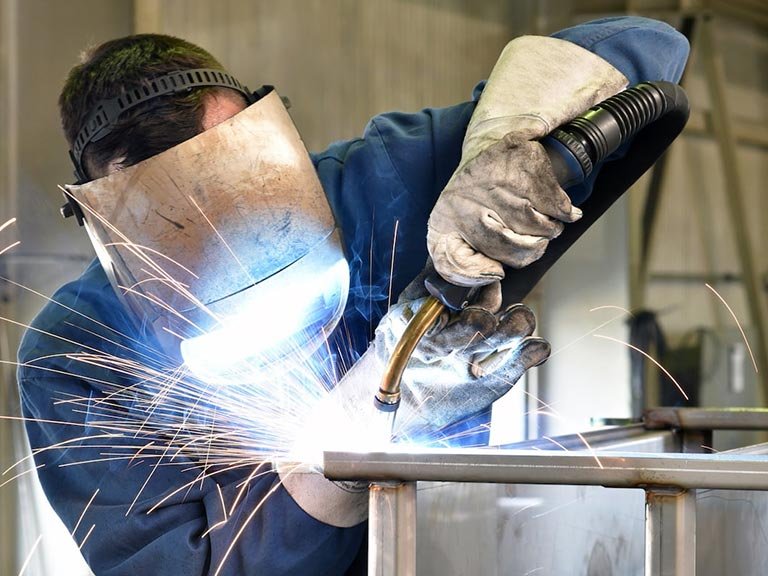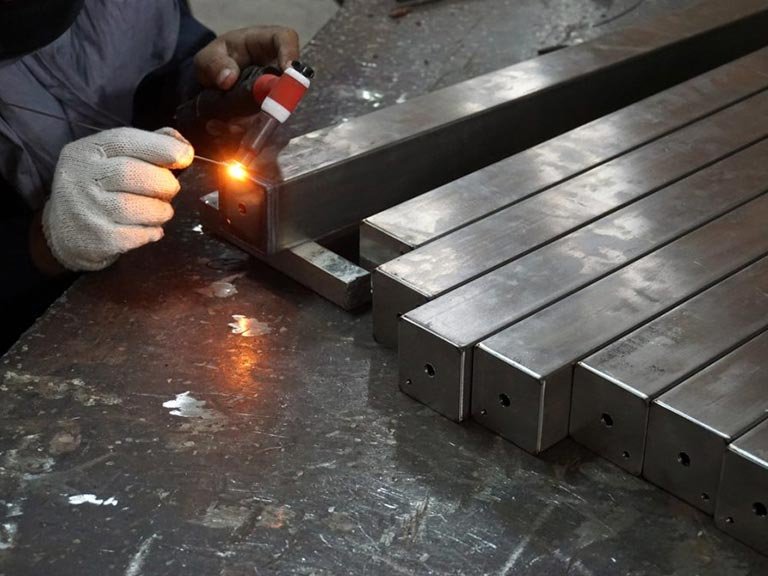Welding is a critical fabrication process used across multiple sectors, including construction, automotive, aerospace, and energy. By applying different processes, we can create strong, permanent bonds between metal components. They are often stronger than the base materials themselves.
At Yonglihao Machinery, we often ponder the significance of welding in modern manufacturing. How does a process that involves joining materials through heat, pressure, or both, become so integral to various industries?
As a leading company in metal processing, we understand the versatility and importance of welding. We have expertise in various welding technologies. Therefore, Yonglihao Machinery can provide you with high-quality metal welding service solutions.
Table of Contents
Understanding Welding: Processes and Techniques
To master welding, one must first grasp the fundamental principles behind different welding techniques and processes. Welding is a complex craft that involves joining metals through the application of heat, pressure, or both. At Yonglihao Machinery, we recognize the importance of understanding these principles to deliver high-quality welding services.
Welding is defined as a process that joins materials, typically metals, by applying heat, pressure, or both, to create a strong and permanent bond. This process often results in a weld that exceeds the strength of the base materials. The basic principle involves melting the metals at the joint to form a weld pool, which, upon cooling, solidifies into a strong bond.
Various welding methods are employed across different industries, each with its unique characteristics and applications. Arc welding, for instance, utilizes an electrical arc to melt and join metals. Other common methods include gas welding, resistance welding, and specialized processes like electron beam and laser welding.
| Welding Method | Characteristics | Applications |
| Arc Welding | Uses an electrical arc to melt metals; versatile and widely used. | Construction, manufacturing, repair services. |
| Gas Welding | Involves the combustion of gas to produce heat; portable and flexible. | Repair work, artistic metalwork, thin metal joining. |
| Resistance Welding | Generates heat through electrical resistance; efficient for mass production. | Automotive, aerospace, electronics manufacturing. |
Understanding the role of electrodes, filler materials, and shielding gases is crucial for achieving high-quality welds. The selection of an appropriate welding method depends on factors such as material type, thickness, and the specific requirements of the final application.
Ready to get started on your next project? Get a personalized estimate for your parts machining needs.
Applications of Welding in Construction Industry
In the construction industry, welding is a fundamental process used in numerous applications, including structural steel fabrication and pipeline construction. The construction industry represents one of the largest sectors utilizing welding processes, with applications ranging from massive infrastructure projects to residential buildings.
Structural Steel Fabrication
In structural steel fabrication, welding is key to connecting steel beams and columns. This forms the framework of buildings and bridges. We use SMAW and GMAW welding, known for their versatility and strength. At Yonglihao Machinery, we offer top-notch metal welding services. These meet the high standards needed for construction, ensuring structures last long and are strong.
| Welding Process | Application | Benefits |
| SMAW | Structural Steel Fabrication | Versatility, Strength |
| GMAW | Structural Steel Fabrication | High Speed, Cleanliness |
Pipeline Construction and Maintenance
Pipeline welding is vital in construction. It joins pipes for fluid or gas transport. SMAW, GMAW, and SAW are used for strong, leak-free connections. We discuss welding codes and standards to ensure safety and reliability in buildings and environments.
- Welding quality impacts safety and environmental protection.
- Quality control is crucial in pipeline construction and maintenance.
Welding in Automotive Manufacturing
Welding is essential in making cars. It uses advanced techniques to join metal parts, ensuring vehicles are strong and last long. Welding is used throughout the assembly process, making sure the vehicle’s structure is solid.
Vehicle Body Assembly and Chassis Fabrication
Resistance spot welding is key in vehicle body assembly. It quickly and consistently joins sheet metal parts. Advanced welding, like arc welding, is used to make the vehicle’s structure strong. This is important for safety during accidents.
- Precision welding is needed for the vehicle’s chassis to ensure its strength.
- New techniques like laser welding and friction stir welding make cars lighter and stronger.
Exhaust Systems and Engine Components
Exhaust systems and engine parts face unique welding challenges. They operate at high temperatures and need to be gas-tight. At Yonglihao Machinery, we provide precise welding services for these parts, meeting industry standards.
- Automation and robotic welding have improved car manufacturing, allowing for more complex welds.
- Modern cars have thousands of welds, ensuring they are safe and strong.

Aerospace Industry Applications
Precision welding is vital in aerospace for joining critical parts with high quality. The aerospace industry uses advanced welding to ensure aircraft safety and structure. We use specialized welding processes for aircraft manufacturing and repair.
Aircraft Fuselage and Wing Construction
Building aircraft fuselage and wings requires welding complex parts. These parts must handle pressurization, aerodynamic loads, and vibration. We use advanced welding like electron beam and precision TIG welding. These techniques ensure aircraft parts are strong and safe for their entire life.
Engine Components and Landing Gear
Welding engine parts is a complex task due to the extreme temperatures and pressures they face. We employ rigorous testing, including radiographic, ultrasonic, and penetrant tests, to detect any flaws. Yonglihao Machinery’s precision welding and quality control systems ensure aerospace standards are met.
Advances in welding technology have made it possible to work with materials like titanium alloys and heat-resistant superalloys. These materials are crucial for modern aircraft performance. Our expertise in welding these materials guarantees high-quality components that meet aerospace industry standards.
Shipbuilding and Maritime Applications
Shipbuilding is a highly welding-intensive industry, requiring precise and durable welds. These welds must withstand harsh marine environments. Welding plays a critical role in constructing and maintaining maritime vessels, ensuring their structural integrity and longevity.
Hull Construction and Structural Components
Building a ship’s hull and its structural components is a complex process. It heavily relies on welding. Submerged arc welding and other high-deposition processes are used for efficient hull construction. This allows for the joining of thick steel plates with deep penetration and high strength.
Structural components in ships, including bulkheads, decks, and support frames, require precise welding techniques. This ensures they can withstand dynamic loads experienced at sea.
Modern shipbuilding increasingly incorporates advanced welding automation. This includes robotic systems and computer-controlled positioning. It improves productivity and consistency in weld quality.
| Welding Process | Application | Benefits |
| Submerged Arc Welding | Hull Construction | High deposition rate, deep penetration |
| Shielded Metal Arc Welding | Repair and Maintenance | Portability, versatility |

Challenges of Welding in Maritime Environments
Maritime applications pose unique welding challenges, including corrosion resistance and exposure to saltwater. Ensuring watertight integrity throughout the vessel’s service life is also crucial. We address these challenges by selecting appropriate welding procedures and materials, and by ensuring compliance with stringent safety regulations.
Attention to joint preparation, cleaning, and surface treatment is essential. This ensures durable welds that can withstand the harsh marine environment.
Welding codes and standards specific to shipbuilding govern material selection, weld design, and inspection procedures. These standards ensure vessel safety and compliance with international regulations.
At Yonglihao Machinery, we understand the specialized requirements of maritime welding applications. We provide solutions that ensure long-term durability in challenging marine environments.
Energy Sector Welding Applications
Welding technologies are crucial for energy infrastructure development and maintenance. We use advanced welding processes to ensure the integrity and efficiency of energy systems. This includes oil and gas pipelines to power generation facilities.
Oil and Gas Pipeline Construction
Welding is essential in constructing and maintaining oil and gas pipelines. It ensures the safe transport of energy resources over long distances. Specialized pipeline welding techniques are employed to meet stringent quality requirements, preventing leaks and environmental damage.
Advanced welding processes like arc welding are used for pipeline construction.
Quality control measures, including non-destructive testing, ensure weld integrity.

Power Plant Equipment and Renewable Energy Structures
In power plants, welding is used to fabricate and repair critical components such as boilers and turbines. It ensures structural integrity and operational efficiency. Renewable energy structures, including wind turbines and solar mounting systems, also rely on welding for their structural integrity.
Welding techniques are adapted for high-pressure, high-temperature conditions in power plants.
Renewable energy projects benefit from welding’s ability to provide strong, durable joints in challenging environments.
At Yonglihao Machinery, we provide welding solutions that meet the exacting standards required for energy sector applications. We ensure reliability and safety in these critical systems.
Metal Welding Services at Yonglihao Machinery
At Yonglihao Machinery, our metal welding services cater to a wide range of industries. We excel in various welding processes, including MIG, TIG, and stick welding. This versatility allows us to work with metals like steel, aluminum, and exotic alloys.
- Types of Welding Services Offered: Our welding services are part of a broader suite of metal processing solutions. This integration supports comprehensive manufacturing, from initial design to final product. We provide:
- Quality Control and Technical Expertise: We adhere to strict quality control measures in our welding processes. This includes verifying materials before welding, monitoring during the process, and inspecting after. Our team’s extensive experience ensures we recommend the best welding method for each project.
Our commitment to advanced welding equipment and technology enhances our capabilities. This dedication delivers superior results for our clients.

Conclusion
Welding is crucial to industrial progress, serving diverse industries from construction to aerospace. It enables the fabrication, repair, and assembly of critical components and structures.
The future of welding will be shaped by technological innovation, evolving material science, and demands for efficiency, quality, and sustainability. Additive manufacturing techniques will play a significant role, enabling the creation of complex components with optimized material properties and reduced waste.
At Yonglihao Machinery, we are committed to evolving our welding capabilities to meet the changing needs of our clients. The development of new metal alloys and composite materials will continue to present challenges and opportunities for welding applications, requiring innovative joining solutions.
FAQ
What is the difference between MIG and TIG welding?
MIG welding employs a continuous wire feed and an inert gas to shield the arc. In contrast, TIG welding uses a non-consumable tungsten electrode and an inert gas. MIG welding is faster and more versatile. TIG welding, however, offers higher precision and is ideal for complex or thin materials.
What are the benefits of using Shielded Metal Arc Welding (SMAW)?
SMAW, or “stick” welding, is versatile and portable. It works well on various metals, including steel and stainless steel. It’s particularly effective for welding thick materials and can be done in different environments.
How does Submerged Arc Welding (SAW) work?
SAW involves feeding a continuous wire electrode into the weld area, covered in flux. The flux shields the arc and protects the weld from gases, resulting in a high-quality weld with minimal porosity.
What are the advantages of using inert gas in welding processes?
Inert gases, like argon and helium, shield the weld area from atmospheric gases. This prevents porosity and contamination, leading to a cleaner, stronger weld.
Can welding be used to join dissimilar metals?
Yes, welding can join dissimilar metals, but it requires careful process and filler material selection. Techniques like friction and explosion welding are often used for this purpose.
What are the key factors in achieving high-quality welds?
To achieve high-quality welds, controlling heat input, welding speed, and shielding gas composition is essential. Proper material preparation, including cleaning and aligning the joint, is also crucial.
How is automation changing the welding industry?
Automation and robotics are transforming the welding industry. They improve efficiency, consistency, and productivity. Automated systems can perform complex welds with high precision, reducing labor costs and enhancing quality.

